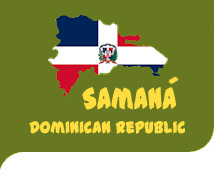
|
 |
| Homepage |
| Hotels |
| Beaches |
| Excursions |
| Gallery |
| Where is Samaná? |
| Weather |
| Info-Samana |
Samaná is located on the coast of the Atlantic Ocean in the northeastern province of the Dominican Republic. Its capital is Santa Bárbara de Samaná. The province, with more than 92,000 inhabitants, spread over 854 km2 of tropical forests, coconut groves, hundreds of beaches with turquoise crystal clear waters, waterfalls and protected national parks. It was discovered on January 12th, 1493 by Christopher Columbus, who was greeted with a barrage of spears and arrows from native Taíno warriors. Each year between the months of February and March, humpback whales leave the cold waters of the North Atlantic and swim down to breed near the shores of Samaná. They can be easily seen from the city port. |
We have over forty websites of our trips. An impressive collection of photos, videos and info from several travel destinations. Here are some of them ... The most popular ¬ Cayo Largo, Cuba Our snorkeling sites ¬ Jibacoa, Cuba « Au Naturel » beaches ¬ Tulum, Mexico Our « coup de coeur » ¬ Peru History and civilisations |

|
|
Samaná is a province of the Dominican Republic located on the coast of the Atlantic Ocean in the north-east of the Dominican Republic. Its capital is Santa Bárbara de Samaná, generally known as Samaná. Samana is known for its mountains of which it is almost fully formed. Samana has several beaches and it is on November 6th, 2006 that the international airport of the province has officially opened its doors. Samaná is expected to become a leading tourist destination in the country. Samana is considered one of the most beautiful areas of the Dominican Republic. Its tourism industry has not reached its full potential. You will find tropical forests, coconut plantations, hundreds of beaches with turquoise waters, waterfalls, protected national parks, etc.. Samana is one of the breeding grounds of the humpback whale. Thousands of humpback whales from the coast, off Samaná from January to March. A highway linking the peninsula of Samana to Santa Domingo, opened to the public in 2008. This highway has cut driving time from four hours to 1.5 hours. There is a major tourism development throughout the peninsula of Samaná, many roads are under construction and / or repaired to facilitate bus transfers from the airport to hotels on the peninsula. The area of the Dominican Republic is 48.442 km2, is the second largest island in the Caribbean. The land of Hispaniola dates back to the prehistoric times, there are millions of years pursuant to immense natural forces, deep cracks have opened on the seabed. Some had volcanic activity, which had the effect of causing the appearance of a multitude of craters on the seabed. One of the biggest is the source of the current Hispaniola. The submarine eruptions and ocean movements formed a thick layer of rock who there are 60 million years, rose pursuant to enormous pressure, and following a drop in sea level, many craters emerged. For millions of years these islands were surrounded by coral reefs, and the end result is the construction of an archipelago of islands, large and small bays, beautiful sandy beaches and impressive coral. The Hispaniola is the second largest and most mountainous island in the Caribbean. The largest part of the island consists of mountain ranges, while the remaining third consists of pleasant plains. It is also surprising that the country has the highest point, but also the lowest of all the Caribbean islands. Highest point: Pico Duarte at 3.175 meters and the lowest point: Lago Enriquillo, a large salt lake with an area of 200 km2, which is 44 meters below sea level despite the fact that is a very mountainous island, it has 400 kms of beach stretching from one side to another. Among other beaches of Puerto Plata, Costambar, Playa Dorada, Sosua, Luperon Cabarete and the north. North of Puerto Plata, Las Terrenas found in Las Galeras, Puerto Escondido, and Portillo. South of the island, there are the beaches of Boca Chica, Juan Dolio, La Romana and Bayahibe and south-east two of the most beautiful beaches in the country, Punta Cana and Bavaro.
|